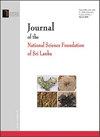天然α-葡萄糖苷酶抑制剂从马来西亚选定的药用植物
IF 0.4
4区 综合性期刊
Q4 MULTIDISCIPLINARY SCIENCES
Journal of the National Science Foundation of Sri Lanka
Pub Date : 2023-06-30
DOI:10.4038/jnsfsr.v51i2.11177
引用次数: 0
摘要
最常见的糖尿病亚型是2型糖尿病,它是由餐后血糖异常升高引起的。抑制人体消化器官中的碳水化合物水解酶(α-葡萄糖苷酶和α-淀粉酶)可以控制血糖水平,使其成为治疗2型糖尿病的重要策略。大多数已开发用于治疗2型糖尿病的口服合成药物价格昂贵且具有不良副作用。因此,植物来源的补救措施已成为首选替代品,因为它们易于获得、负担得起且危害较小。Angustine(1)Nauclea subdata(Korth.)Steud的主要成分。,和(E)-labda-8(17)、12-二烯-15,16-二醛(2)和巴汉葛山豆的泽鲁明A(3)对α-葡萄糖苷酶的抑制活性进行了评价。(E) -Labda-8(17),12-dien-15,16-dial(2)(IC50=39.7μM)被确定为三者中最有效的抑制剂,其次是angustine(1)(IC50=48.1μM)和zerumin A(3)(IC50:53.3μM)。酶动力学研究表明,angustine(1)是一种混合型抑制剂,而(E)-labda-8(17)、12-dien-15,16-dial(2)和zerumin a(3)是非竞争性抑制剂。进行了分子对接和分子动力学(MD)模拟研究,以预测配体与靶蛋白1AGM(来自泡盛曲霉的阿卡波糖与葡糖淀粉酶的复合物)之间的关键相互作用。结合相互作用能的研究结果表明,angustine(1)具有作为天然药物先导治疗2型糖尿病的潜力。本文章由计算机程序翻译,如有差异,请以英文原文为准。
Natural α-glucosidase inhibitors from selected medicinal plants in Malaysia
The most prevalent subtype of diabetes is Type 2 Diabetes Mellitus which results from an abnormal postprandial increase in blood glucose. Inhibition of the carbohydrate-hydrolysing enzymes (alpha-glucosidase and alpha-amylase) in the human digestive organs can control blood glucose levels, making it an important strategy in the management of Type 2 Diabetes Mellitus. A majority of the oral synthetic drugs which have been developed to treat Type 2 Diabetes Mellitus are expensive and have undesirable side effects. As a result, plant-derived remedies have become preferred alternatives as they are easily available, affordable and less harmful. Angustine (1) the major constituent in Nauclea subdita (Korth.) Steud., and (E)-labda-8(17),12-dien-15,16-dial (2) and zerumin A (3) of Alpinia pahangensis Ridley were evaluated for their α-glucosidase inhibitory activity. (E)-Labda-8(17),12-dien-15,16-dial (2) (IC50 = 39.7 μM) was identified as the most potent inhibitor among all three, followed by angustine (1) (IC50 = 48.1 μM) and zerumin A (3) (IC50 = 53.3 μM). Enzyme kinetic studies indicated that angustine (1) was a mixed-type inhibitor, while (E)-labda-8(17),12-dien-15,16-dial (2), and zerumin A (3) were non-competitive inhibitors. Molecular docking and molecular dynamics (MD) simulation studies were performed to predict the key interactions between the ligands and the target protein, 1AGM (complex of acarbose with glucoamylase from Aspergillus awamori). The results of the study of binding interaction energy suggested that angustine (1) has the potential to be used as a natural drug lead in the treatment of type 2 diabetes mellitus.
求助全文
通过发布文献求助,成功后即可免费获取论文全文。
去求助
来源期刊

Journal of the National Science Foundation of Sri Lanka
MULTIDISCIPLINARY SCIENCES-
CiteScore
0.90
自引率
0.00%
发文量
57
审稿时长
>12 weeks
期刊介绍:
The Journal of National Science Foundation of Sri Lanka (JNSF) publishes the results of research in Science and Technology. The journal is released four times a year, in March, June, September and December. This journal contains Research Articles, Reviews, Research Communications and Correspondences.
Manuscripts submitted to the journal are accepted on the understanding that they will be reviewed prior to acceptance and that they have not been submitted for publication elsewhere.
 求助内容:
求助内容: 应助结果提醒方式:
应助结果提醒方式:


